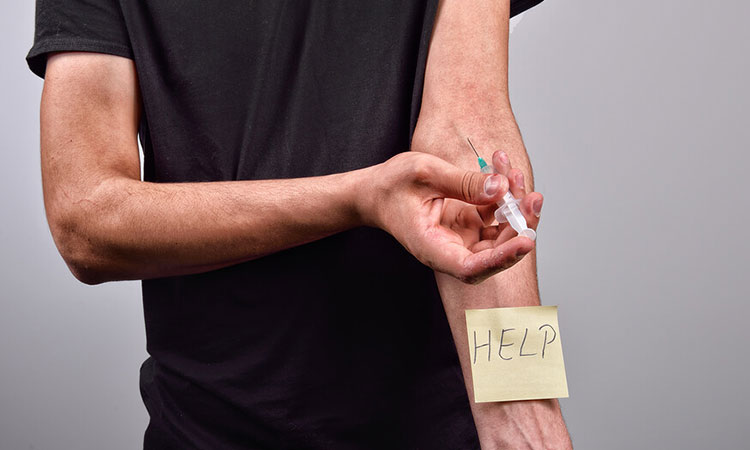
Suboxone is very effective at providing relief from heroin withdrawal and cravings, but the should only be used as directed as part of a comprehensive treatment program. Clinicians who work at treatment centers can determine an appropriate dose, and they can integrate the use of the medication with therapy and counseling.
Suboxone contains buprenorphine and naloxone. Buprenorphine is a partial opioid agonist, meaning that it activates the opioid receptors in the brain, but to a much lesser extent than a full agonist, such as heroin. Buprenorphine also works as an antagonist, meaning it prevents other opioids from attaching to transmitters while inducing some opioid effect of its own to suppress withdrawal symptoms and cravings.
Naloxone is a full opioid antagonist that is used by first responders to reverse the effects of an opioid overdose in progress. As a component of Suboxone, it prevents overdose and is intended to help prevent misuse.
What Is Heroin?
Heroin is an extraordinarily addictive, schedule I substance derived from morphine, an alkaloid extracted from poppy seeds. There are several varieties of heroin, but it is most often found as a white powder that can be snorted or smoked, or diluted for injecting.
Heroin is an opioid, not unlike prescription drugs such as oxycodone and hydrocodone. These drugs are used to relieve pain because they attach to opioid receptors in the brain and temporarily increase pain tolerance, reduce the severity of pain, and lower the body’s response to pain.
Once heroin enters the brain, it is converted into morphine and attaches to the same opioid receptors, producing an intense rush for the user. After several hours, this rush subsides, and drowsiness takes over, accompanied by reduced heart rate, breathing, and cognitive function.
Why Use Suboxone for Heroin Withdrawal?
One of the benefits of using Suboxone is that it cannot be used to achieve a full opioid effect, making it much more difficult to abuse than other forms of opioid replacement therapies, such as methadone. Furthermore, if a Suboxone tablet is crushed and snorted, the added naloxone will block opioids from attaching to the brain’s receptors, preventing the desired euphoric feelings that heroin users crave.
Unlike methadone, a drug that can only be dispensed from a specialized addiction clinic, Suboxone can be prescribed by a doctor. According to the World Health Organization, only about 10% of people who suffer from a physiological dependence to opioids are receiving treatment for it. In clinical studies, Suboxone has been shown to be effective, and it also broadens treatment options for those who have limited access to them.
Overall, the benefits of Suboxone include the following:
- Greater accessibility
- Lower potential for abuse
- High success rate in the treatment of opioid dependence
Can Suboxone Be Dangerous?
Although can be an invaluable resource for those seeking recovery from opioid addiction, like all medications, it may have some disadvantages. Aside from potential side effects, Suboxone is a drug that users may take for a long time to sustain recovery. As a partial opioid agonist, it may still produce some opioid dependence in users.
For this reason, when users seek to get off Suboxone, they should taper their dosage under medical direction. Also, like other medication-assisted treatments, Suboxone does not “cure” addiction and should only be used in accordance with a comprehensive treatment program.
However, Suboxone is much less likely to lead to the same addictive behavior as full opioid agonists because it has a slower onset and a milder effect. While addiction is possible with this medication, there is only a relatively low risk of this occurring.

Switching from Heroin to Suboxone
As noted, Suboxone is a medication that can relieve symptoms of opioid withdrawal by causing less receptor activation than a full agonist. At low doses, partial agonists may produce effects comparable to their full agonist counterparts.
However, when a dose of a partial agonists increases, the analgesic action will plateau. At this point, further increases in dose will not provide further relief, but may only serve to increase the adverse effects. Suboxone can help users of heroin transition into treatment more effectively by preventing them from having painful withdrawal symptoms and cravings.
Furthermore, should users venture to take other opioids while using Suboxone, these opioids will be obstructed from the brain’s receptors by Suboxone use, preventing the desired high that is produced from these drugs. This action can assist in annulling the positive reinforcement cycle that previously led to the addiction because users will no longer experience the same reward for opioid use.
Users will also not encounter the withdrawal symptoms that typically manifest from discontinuing opioid use, making it easier to adhere to a treatment program.
If you or someone you love is addicted to heroin, please contact us as soon as possible to find out how we can help you reclaim your life and experience the happiness and wellness you deserve!